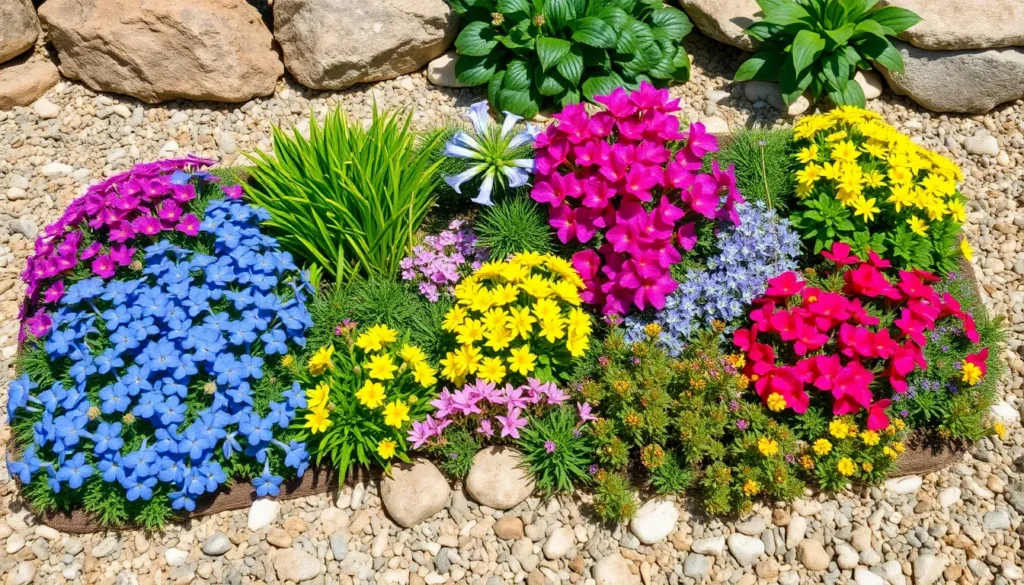Rock gardens offer a stunning way to transform challenging terrain into breathtaking landscapes that thrive with minimal maintenance. We’ve discovered that the secret to creating these dramatic outdoor spaces lies in selecting the right plants that not only survive but flourish among stones and gravel.
Whether you’re dealing with a steep slope that’s difficult to mow or simply want to add visual interest to your yard, rock garden plants provide the perfect solution. These resilient beauties are naturally adapted to harsh conditions and poor soil, making them ideal for homeowners who want maximum impact with minimal effort.
We’ll explore the most spectacular plant varieties that’ll turn your rocky terrain into a show-stopping garden feature. From cascading sedums that spill over boulders to vibrant alpine flowers that peek through stone crevices, you’ll discover how to create a low-maintenance industry that looks professionally designed and thrives year after year.
Choose Low-Growing Perennials for Rock Garden Foundation
Building a strong rock garden foundation requires selecting perennials that stay compact and spread naturally across rocky terrain. These ground-hugging plants create the essential base layer that supports taller specimens while filling gaps between stones with continuous color and texture.
Select Creeping Phlox for Colorful Ground Coverage
Creeping phlox delivers spectacular spring blooms that carpet rock gardens in vibrant pink, purple, white, or blue flowers. We recommend planting this hardy perennial in full sun locations where it spreads 12 to 18 inches wide while staying only 4 to 6 inches tall. The needle-like evergreen foliage provides year-round structure even after the stunning flower display fades in late spring.
Establishing creeping phlox requires well-draining soil and minimal water once the roots develop. Plant spacing of 12 inches apart allows each clump to expand naturally without overcrowding neighboring plants. This reliable ground cover thrives in USDA zones 3 through 9 and tolerates poor soil conditions that challenge other flowering plants.
Plant Sedum Varieties for Drought-Resistant Beauty
Sedum varieties offer unmatched drought tolerance while producing succulent foliage in shades of green, red, purple, or silvery blue. We’ve found that low-growing species like Sedum spurium and Sedum acre create dense mats that suppress weeds naturally. These hardy succulents store water in their thick leaves, making them perfect for hot, dry rock garden locations.
Different sedum types bloom at various times throughout the growing season, extending visual interest from spring through fall. Golden sedum produces bright yellow flowers in early summer, while autumn joy sedum develops pink flower clusters that attract butterflies in late summer. Most varieties reach heights between 2 to 8 inches and spread 12 to 24 inches wide.
Incorporate Hens and Chicks for Year-Round Interest
Hens and chicks (Sempervivum) create architectural focal points with their distinctive rosette formations and incredible cold hardiness. We love how these unique succulents produce “chicks” or baby plants around the mother “hen,” naturally expanding colonies over time. The thick, pointed leaves often display stunning color variations including deep reds, purples, and silvery greens.
These remarkable perennials survive temperatures down to -30°F and require virtually no maintenance once established. Each rosette grows 2 to 4 inches tall and 3 to 6 inches wide, making them ideal for tucking into rock crevices or creating geometric patterns. Hens and chicks bloom once in their lifetime, sending up tall flower spikes before the main plant dies and passes the colony to its offspring.
Select Alpine Plants for Authentic Mountain Appeal
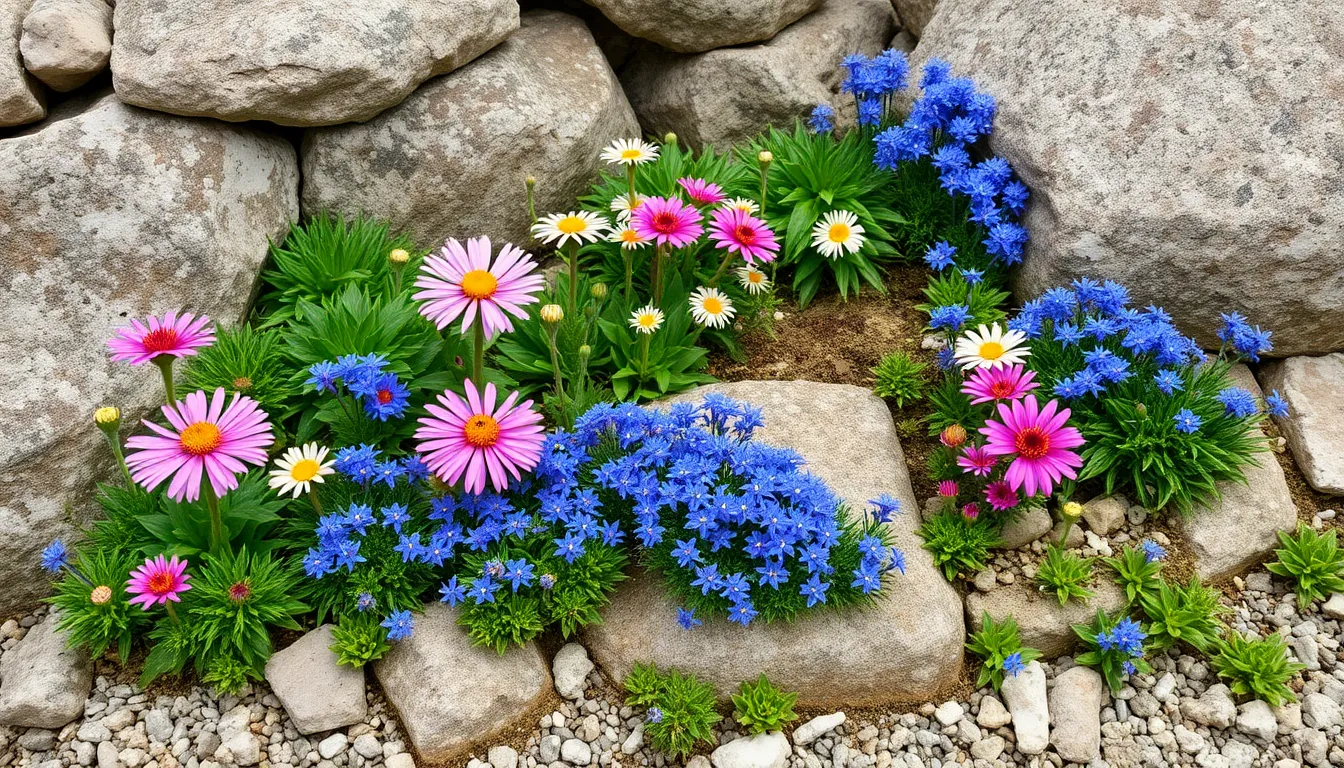
Alpine plants bring genuine mountain character to our rock gardens while thriving in the challenging conditions that make these spaces unique. These hardy specimens naturally flourish in rocky, well-drained environments and offer the authentic appeal we’re seeking.
Add Alpine Asters for Late-Season Blooms
Alpine asters extend our garden’s beauty well into fall when most plants begin to fade. These compact perennials produce cheerful daisy-like flowers in late summer through autumn, ensuring our rock garden maintains vibrant color throughout the growing season. We’ll find their purple, pink, and white blooms create stunning contrasts against the neutral tones of stone and gravel.
Positioning alpine asters in sunny locations with excellent drainage maximizes their blooming potential. Their low-growing habit makes them perfect for tucking between larger rocks or cascading over stone edges. These resilient plants tolerate poor soil conditions and require minimal water once established, making maintenance virtually effortless.
Plant Gentians for Striking Blue Flowers
Gentians deliver some of the most intense blue flowers we can add to our rock garden palette. Their trumpet-shaped blooms create dramatic focal points that stand out brilliantly against rocky backgrounds and neutral-colored stones. We’ll appreciate how these authentic alpine natives thrive in the well-drained, gritty soil conditions that rock gardens naturally provide.
Selecting gentians for cooler microclimates within our rock garden ensures optimal performance. These mountain specialists prefer locations with morning sun and afternoon shade, making them ideal for the north-facing sides of larger stones. Their compact growth habit and preference for lean soil align perfectly with traditional rock garden growing conditions.
Include Saxifrage for Delicate Rock Crevice Growth
Saxifrage plants excel at filling the narrow spaces between rocks that challenge other garden plants. These specialized alpine performers form attractive low mats of foliage topped with delicate star-shaped flowers in spring. We’ll find their ability to thrive in tight crevices and poor soil makes them indispensable for authentic rock garden design.
Establishing saxifrage in well-drained, gritty soil ensures long-term success in our mountain-themed industry. Their shallow root systems allow them to flourish where soil depth is limited, while their drought tolerance eliminates the need for supplemental watering. These hardy perennials return year after year, gradually spreading to create natural-looking colonies that enhance the wild mountain aesthetic we’re cultivating.
Incorporate Ornamental Grasses for Texture and Movement
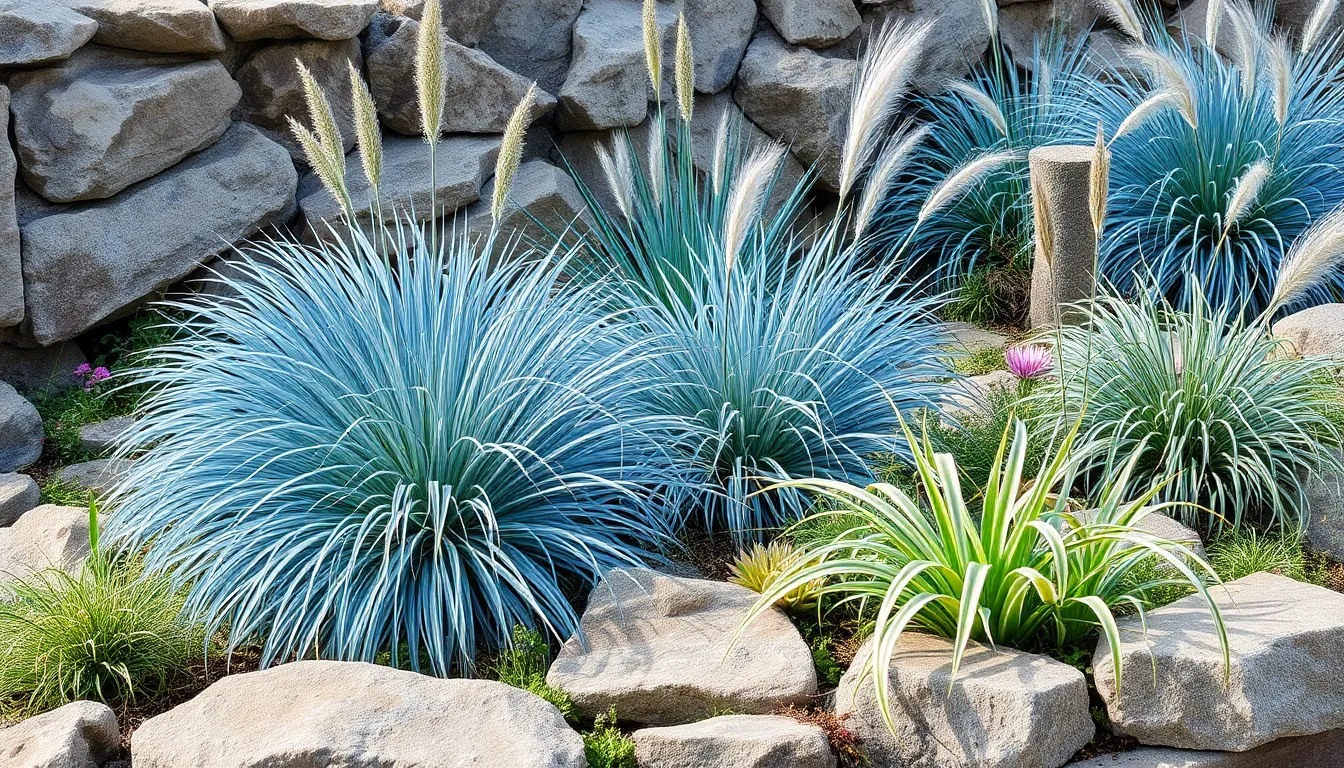
Ornamental grasses introduce soft, flowing elements that create ever-changing visual contrast against the hard surfaces of rocks in your garden. These versatile plants bring natural movement as their fine blades and plumes sway gently in the breeze, softening rugged rock edges while adding year-round interest to your industry.
Choose Blue Fescue for Compact Silvery Foliage
Blue fescue (Festuca glauca) stands out as one of our top recommendations for rock gardens due to its neat, clumping growth habit and striking silvery-blue foliage. This compact grass stays small and manageable, making it perfect for edging pathways or filling rock crevices as groundcover. We love how its cool blue tones create beautiful contrast against warm stone colors, adding visual depth to your rock garden design. The plant’s tidy appearance requires minimal maintenance while providing consistent color throughout the growing season.
Plant Fountain Grass for Graceful Swaying Effect
Fountain grass (Pennisetum species) brings an elegant, flowing quality to rock gardens with its gracefully arching blades and delicate flower plumes. We appreciate how this grass moves with even the slightest breeze, creating a fluid, soft texture that enhances the naturalistic feel of your rock industry. The ornamental plumes add seasonal interest, particularly in late summer and fall when they develop their full, feathery appearance. This grass works exceptionally well as a focal point or backdrop for smaller rock garden plants.
Add Sedge Varieties for Low-Maintenance Options
Sedge grasses (Carex species) excel in rock gardens because of their remarkable tolerance for poor soils and minimal water requirements. We recommend these hardy plants for gardeners seeking low-maintenance answers that still provide excellent texture and evergreen foliage. Sedges effectively fill spaces between rocks while requiring very little care once established. Their fine texture complements both the hard surfaces of stones and the softer elements of companion plants like succulents, cotoneasters, rock soapwort, or euphorbia firesticks, creating a diverse and resilient industry.
Add Flowering Shrubs for Structure and Height
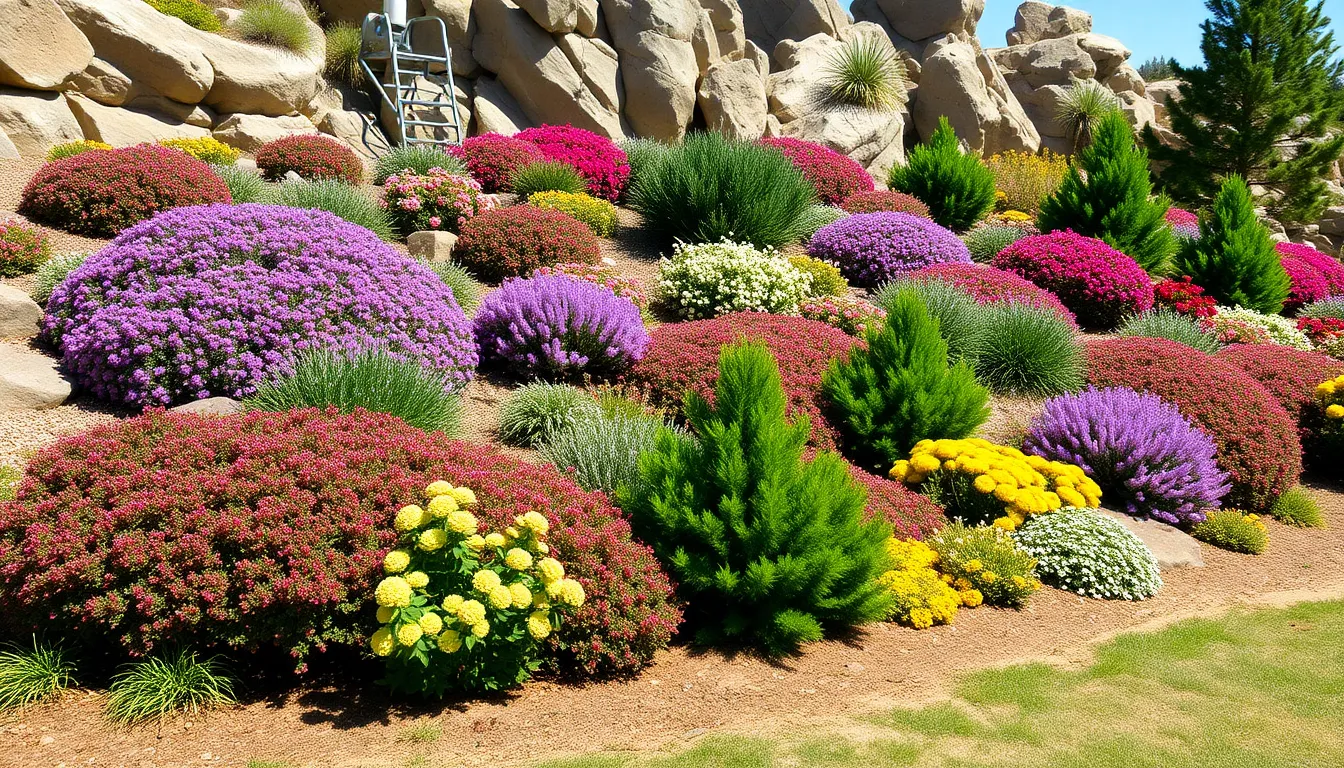
Flowering shrubs create the essential vertical backbone that transforms our rock garden from a flat industry into a ever-changing, multi-dimensional space. We’ll break up the low-lying foundation plants we’ve established by introducing height variations and seasonal color through strategic shrub placement.
Plant Dwarf Conifers for Evergreen Framework
Dwarf conifers like Pinus mugo (mugo pine) and Chamaecyparissus (dwarf cypress) provide year-round structure that anchors our rock garden design. These compact evergreens create a sturdy framework around which we can arrange seasonal flowering plants and ground covers. Their slow growth patterns ensure they won’t overwhelm the space or require frequent pruning.
We position these conifers in key locations where we need permanent vertical elements that maintain their appearance through all seasons. The full sun and well-drained soil conditions typical of rock gardens suit these plants perfectly. Their needle textures create striking contrasts against the flowing forms of ornamental grasses and the delicate blooms of alpine plants we’ve already incorporated.
Include Heather for Fragrant Seasonal Blooms
Heather species (Calluna vulgaris and Erica varieties) bring vibrant late summer and fall color along with pleasant fragrance that enriches our garden’s sensory appeal. These hardy shrubs thrive in the acidic, well-drained soils commonly found around rock formations and sloped areas. We plant heather in clusters to create sweeping drifts of color that complement our existing alpine asters and gentians.
The long-lasting blooms extend our garden’s interest well into autumn when many other plants begin to fade. Heather’s compact growth habit makes it ideal for filling mid-level spaces between our low-growing sedums and taller dwarf conifers, creating smooth transitions throughout the industry.
Select Cotoneaster for Berries and Fall Color
Cotoneaster offers exceptional versatility with its tolerance for poor soil conditions and drought stress that challenge other shrubs. We choose this spreading shrub for its attractive berry display in late summer and fall, which adds visual interest while attracting beneficial birds to our garden. The deciduous varieties provide striking autumn foliage that creates seasonal drama alongside our fountain grass and blue fescue.
This hardy shrub forms dense, spreading mats that help control erosion between rock placements while adding essential texture variation. We position cotoneaster in areas where we need reliable ground coverage that won’t compete with our carefully placed dwarf conifers or interfere with the natural growth patterns of our established perennial foundation.
Include Cacti and Succulents for Desert Rock Garden Themes
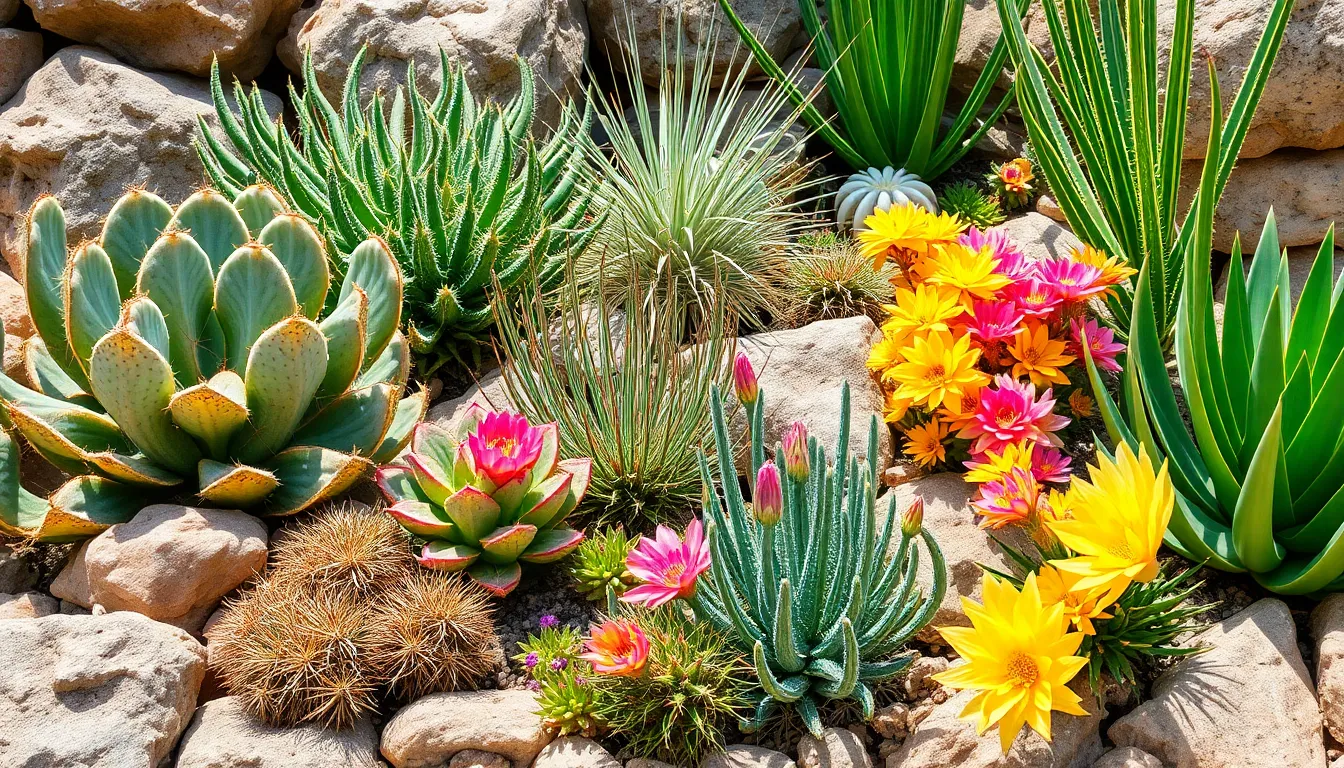
Building on our foundation of alpine plants and ornamental grasses, we can create stunning desert themed sections within our rock gardens using drought tolerant cacti and succulents. These remarkable plants bring bold textures and vibrant colors while requiring minimal water and maintenance.
Choose Hardy Opuntia for Cold-Climate Success
Opuntia species stand out as the most cold hardy cacti options for rock gardens in temperate climates. We recommend these prickly pear cacti because they withstand freezing temperatures far better than other succulent varieties. Their flat, paddle shaped segments create interesting architectural forms throughout winter months when many other plants go dormant.
Eastern prickly pear (Opuntia humifusa) tolerates temperatures down to -20°F, making it suitable for USDA zones 4-9. Fragrant Pear (Opuntia fragilis) survives even colder conditions and produces cheerful yellow blooms in late spring. Plant these hardy cacti in well drained, sandy soil with full sun exposure for optimal growth and winter survival.
Plant Yucca for Dramatic Architectural Elements
Yucca plants deliver bold vertical statements that contrast beautifully with low growing ground covers we’ve already established. Their sword like leaves create striking focal points while requiring virtually no supplemental watering once established. Most varieties produce spectacular tall flower spikes that can reach 6-8 feet in height during summer blooming periods.
Adam’s needle (Yucca filamentosa) thrives in zones 5-10 and produces fragrant white bell shaped flowers on towering stalks. Red yucca (Hesperaloe parviflora) offers coral colored tubular blooms that attract hummingbirds throughout the growing season. Position these architectural beauties near larger rocks or at garden transitions where their dramatic form can serve as natural sculptures.
Add Ice Plants for Vibrant Carpet Coverage
Ice plants transform bare rock surfaces into colorful carpets that bloom prolifically with minimal care. Delosperma cooperi produces masses of bright purplish pink daisy like flowers from late spring through fall. These low growing succulents spread just 1-2 inches tall but can cover several feet in width.
Hardy ice plant (Delosperma nubigenum) displays brilliant yellow flowers and tolerates temperatures down to -20°F in well drained conditions. Cooper’s ice plant blooms continuously in full sun and sandy soils, creating stunning displays between rock crevices. Plant these spreading succulents to fill gaps, prevent erosion, and add consistent color throughout the growing season.
Plant Native Species for Regional Rock Garden Success
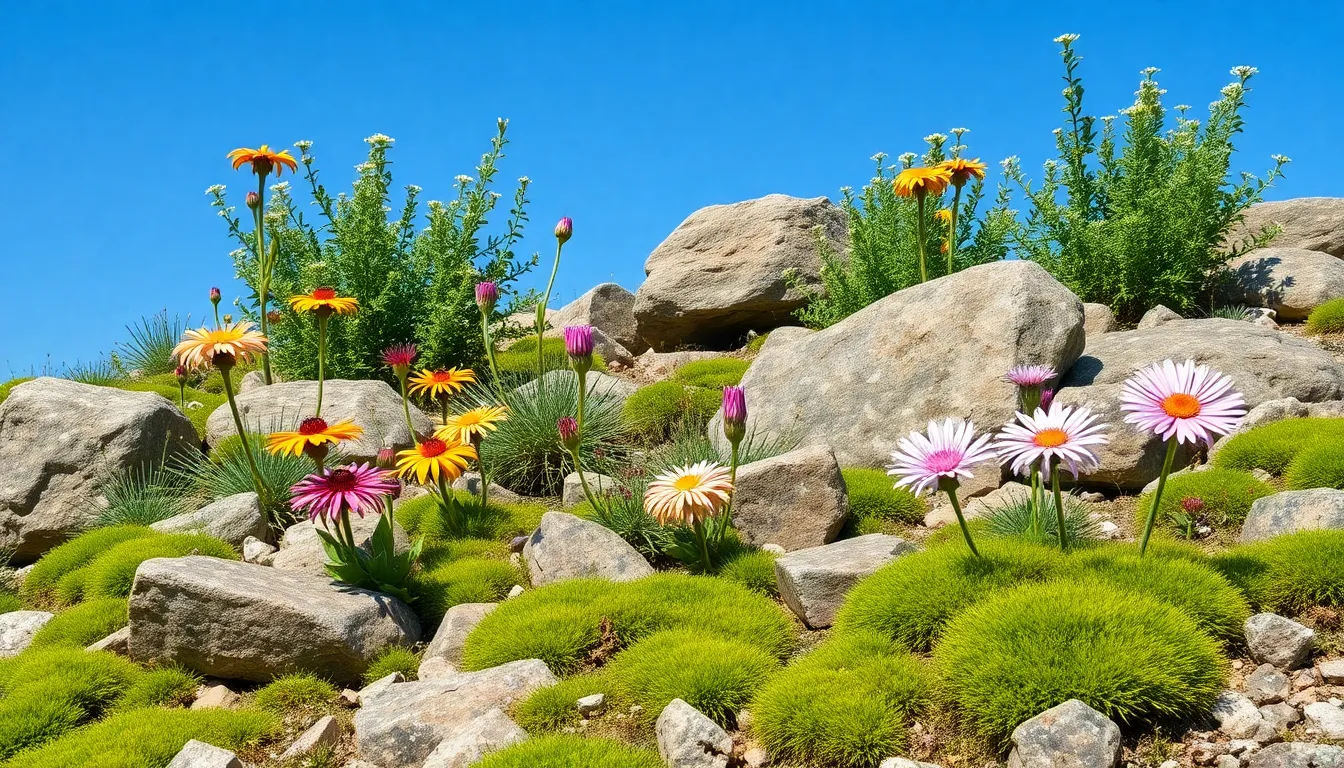
Selecting plants native to your exact region creates the most sustainable and authentic rock garden industry. Native species naturally adapt to local soil conditions, climate patterns, and seasonal changes without requiring extensive maintenance or artificial support systems.
Research Local Wildflowers for Natural Integration
Wildflowers native to your area provide the most reliable color and texture combinations for rock garden success. We recommend starting with species like butterfly milkweed (Asclepias tuberosa) and rattlesnake master (Eryngium yuccifolium) for their exceptional drought tolerance and pollinator appeal. Prairie blazing star (Liatris scariosa) offers vertical purple spikes that complement the horizontal lines of rock formations.
Missouri evening primrose (Oenothera macrocarpa) delivers bright yellow blooms that open in the evening, creating ever-changing seasonal interest. Lanceleaf coreopsis (Coreopsis lanceolata) produces cheerful daisy like flowers throughout the growing season while requiring minimal water once established. Purple poppy mallow (Callirhoe involucrata) spreads naturally across rocky surfaces, creating flowing carpets of magenta blooms.
These wildflower selections thrive in well drained, rocky soils and integrate seamlessly with existing local ecosystems. Regional wildflowers also support native pollinators like butterflies and bees, creating beneficial wildlife corridors within your industry design.
Select Indigenous Shrubs for Wildlife Support
Indigenous shrubs provide essential structure and year round framework while supporting local wildlife populations. Leadplant (Amorpha canescens) serves as an excellent foundation shrub with its silvery foliage and purple flower spikes that attract beneficial insects. Pale purple coneflower (Echinacea pallida) and purple prairie clover (Dalea purpurea) offer mid height options that bridge the gap between ground level plantings and taller industry elements.
Winterberry provides brilliant red berries that persist through winter months, offering crucial food sources for birds during harsh weather. Prairie rose creates natural habitat while producing fragrant blooms followed by colorful hips that extend seasonal interest. Dwarf ninebark delivers white spring flowers and distinctive peeling bark that adds textural contrast to stone surfaces.
New Jersey tea thrives in poor, rocky soils while producing clusters of white flowers that attract diverse pollinators. Lowbush blueberry contributes edible berries for both wildlife and gardeners while displaying spectacular fall foliage colors. These shrub selections require minimal irrigation once established and provide essential nesting sites and food sources for native bird species.
Choose Regional Mosses for Authentic Ground Cover
Regional mosses create the most natural appearing ground cover for filling rock crevices and softening hardscape edges. Native moss species adapt perfectly to local moisture patterns and temperature fluctuations without requiring supplemental watering or fertilization. Moss campion varieties establish quickly in rocky environments and form dense, cushion like mats that prevent soil erosion.
Local moss varieties found naturally on rock outcrops in your region provide the most authentic appearance and highest survival rates. These species colonize naturally in shaded crevices and north facing rock surfaces where other plants struggle to establish. Regional mosses also help retain moisture around plant roots while creating microhabitats for beneficial insects and small wildlife.
We suggest collecting small samples of native mosses from nearby natural areas to propagate in your rock garden setting. This approach ensures genetic compatibility with local environmental conditions while supporting the authentic regional character of your industry design.
Consider Seasonal Interest Plants for Year-Round Appeal
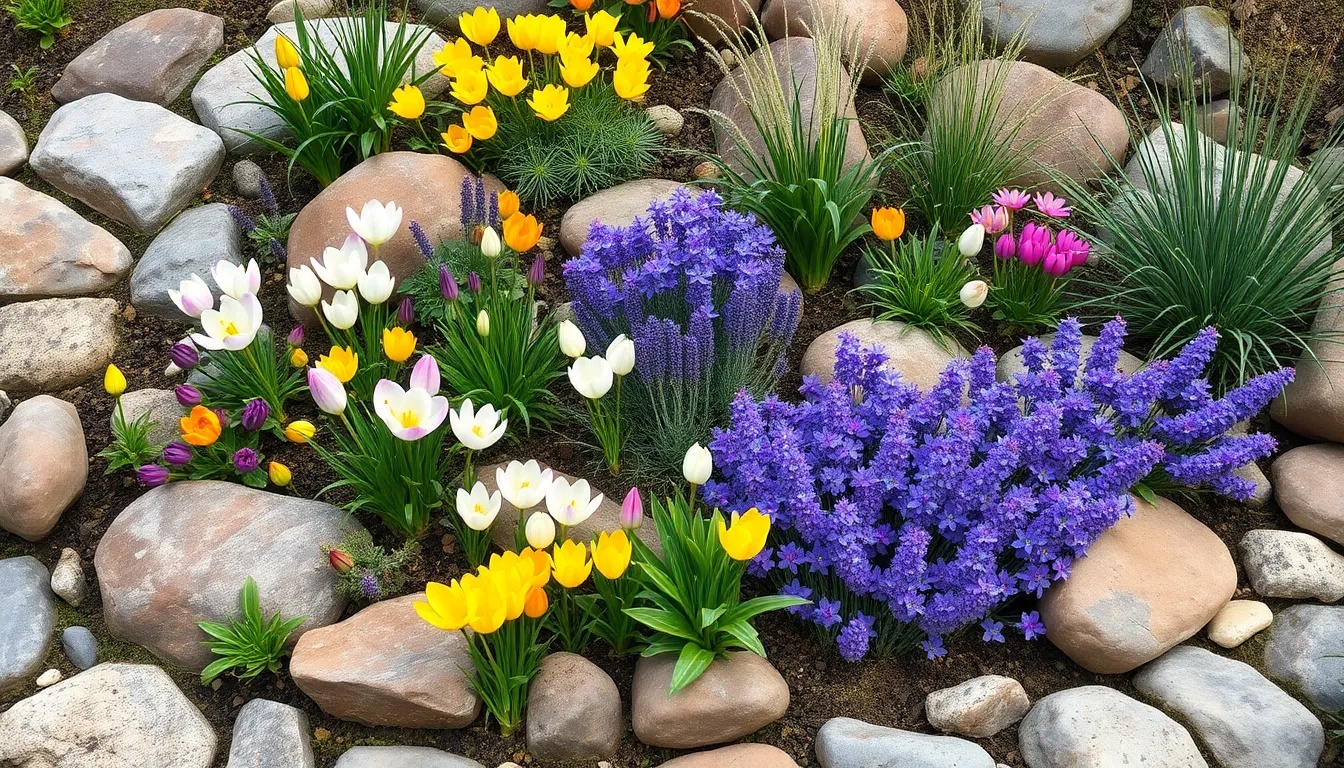
We need strategic plant selection that provides visual interest throughout every season to maximize our rock garden’s impact. Incorporating plants with varied blooming periods and foliage changes ensures continuous beauty from spring through winter.
Plan Spring Bulbs for Early Color Bursts
Crocus varieties emerge as the earliest spring performers, pushing through snow and rocky terrain to deliver vibrant purple, yellow, and white blooms. These hardy bulbs thrive in well-drained soil and require minimal care once established. We recommend planting them in clusters between larger rocks for maximum visual impact.
Grape hyacinth creates stunning blue carpets that complement the natural stone colors perfectly. Their compact size makes them ideal for tight spaces between rocks, and they’ll naturalize over time to create larger displays. Position these bulbs in areas that receive at least 6 hours of daily sunlight for optimal flowering.
Small tulip species offer bright color bursts without overwhelming the delicate scale of rock gardens. Unlike their larger cousins, these diminutive varieties won’t flop over or require annual replanting. Yellow Alyssum provides another excellent early spring option, delivering masses of golden flowers while tolerating drought conditions and poor soil quality.
Select Summer Bloomers for Peak Season Display
Lavender species deliver fragrant purple spikes that attract beneficial insects while requiring virtually no maintenance. Lavandula angustifolia performs exceptionally well in rocky conditions, tolerating drought and poor soil while providing aromatic foliage year round. Plant these shrubs in sunny locations with excellent drainage for best results.
Foxtail agave creates dramatic architectural elements with its sword-like leaves and eventual towering flower spikes. This succulent thrives in hot, dry conditions and adds southwestern flair to rock garden designs. We suggest using it as a focal point among lower-growing plants.
Heuchera americana contributes colorful foliage in shades of purple, burgundy, and green that persist throughout the growing season. Their delicate flower spikes add vertical interest without blocking views of other plants. These perennials adapt well to rocky conditions and tolerate some shade if necessary.
Ornamental grasses introduce movement and texture while requiring minimal water once established. Pinus mugo adds evergreen structure and natural mountain appeal to complement seasonal bloomers.
Include Fall Foliage Plants for Autumn Beauty
Santolina species transform from silvery summer foliage to warm golden tones as temperatures cool. Their compact, rounded growth habit makes them perfect for filling spaces between larger rocks. These Mediterranean natives continue providing structure even after other perennials have gone dormant.
Deciduous alpine plants create spectacular autumn displays with leaves turning brilliant shades of yellow, orange, and red. Their mountain origins make them naturally adapted to rocky, well-drained conditions. We recommend selecting species native to your region for best cold hardiness and lowest maintenance requirements.
Fall-blooming perennials extend the flowering season well into autumn when many other plants are finished. Alpine asters provide late-season purple and pink blooms that create beautiful contrasts with changing foliage colors. Position these plants in sunny, well-drained areas where they’ll receive protection from harsh winter winds.
Conclusion
Rock garden landscaping offers us an incredible opportunity to transform challenging spaces into breathtaking natural displays. We’ve explored how the right plant combinations can create sustainable gardens that thrive with minimal intervention while providing year-round beauty.
The key to success lies in selecting plants that naturally complement rocky terrain and poor soil conditions. From drought-resistant succulents to hardy alpine flowers we can build diverse ecosystems that support local wildlife while reducing maintenance demands.
By incorporating native species alongside carefully chosen ornamentals we’re not just creating beautiful landscapes—we’re contributing to environmental sustainability. These thoughtful plant choices ensure our rock gardens will flourish for years to come while providing endless enjoyment and natural charm.
Frequently Asked Questions
What are the main benefits of creating a rock garden?
Rock gardens transform challenging landscapes with minimal upkeep while enhancing steep slopes and poor soil areas. They provide year-round visual interest, require less water than traditional gardens, and offer natural weed suppression. Rock gardens also create unique architectural features that work well in difficult terrain where other landscaping might struggle.
Which plants work best as a foundation for rock gardens?
Low-growing perennials like creeping phlox provide colorful spring blooms and spread naturally across rocky terrain. Sedum species offer drought resistance and succulent foliage, while hens and chicks add architectural beauty with excellent cold hardiness. These plants establish strong foundations and thrive in poor soil conditions.
How do alpine plants enhance rock garden authenticity?
Alpine plants create authentic mountain appeal with specialized adaptations to harsh conditions. Alpine asters provide vibrant fall colors, gentians offer striking blue focal points, and saxifrage fills narrow rock crevices naturally. These plants thrive in well-drained areas and cooler microclimates, mimicking natural mountain environments perfectly.
What role do ornamental grasses play in rock gardens?
Ornamental grasses add texture and movement while requiring minimal maintenance. Blue fescue provides compact silvery foliage that contrasts beautifully with stones. Fountain grass creates graceful swaying effects, and sedge varieties thrive in poor soils. These grasses enhance the garden’s natural appearance year-round.
Which flowering shrubs work well in rock gardens?
Dwarf conifers like mugo pine provide year-round framework and structure. Heather species offer fragrant blooms and vibrant late-season colors. Cotoneaster provides attractive berries, fall foliage, and erosion control. These shrubs create vertical elements and seasonal interest while adapting well to rocky conditions.
Can cacti and succulents survive in rock gardens?
Yes, hardy species like Eastern prickly pear and Fragrant Pear tolerate cold temperatures while providing unique architectural forms. Yucca plants add dramatic vertical elements, and ice plants create vibrant carpet coverage with minimal care. Choose cold-hardy varieties suited to your climate zone for best results.
Why should I include native plants in my rock garden?
Native plants adapt naturally to local soil and climate conditions, requiring minimal maintenance once established. Regional wildflowers like butterfly milkweed attract pollinators, while indigenous shrubs provide structural support and wildlife benefits. Native species create sustainable, eco-friendly gardens that support local ecosystems effectively.
How can I ensure year-round visual interest in my rock garden?
Plant spring bulbs like crocus and grape hyacinth for early color, summer bloomers like lavender for fragrance, and fall foliage plants like Santolina for autumn displays. Combine evergreen elements with seasonal bloomers and colorful foliage plants to maintain visual appeal throughout all seasons.

